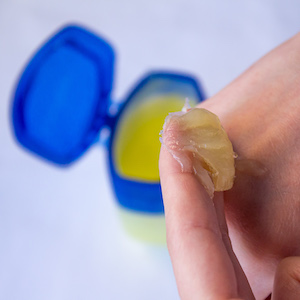Petroleum: Why it’s one of dermatologist’s favorite ingredients
- Posted on: Sep 25 2023
 Did you grow up with a tub of Vaseline in your bathroom cabinet? Still have one there now? Most people would answer yes.
Did you grow up with a tub of Vaseline in your bathroom cabinet? Still have one there now? Most people would answer yes.
What’s not to love? Petroleum jelly is an easy-to-find, inexpensive product with multiple skin care uses for the entire family, from soothing a baby’s bottom to moisturizing dry skin to healing injuries. You might be surprised to learn that this simple product can even slow the signs of aging and help treat chronic skin conditions like rosacea and psoriasis.
The skin care experts at Asarch Dermatology invite you to take a closer look at the power of petroleum jelly – and why we recommend making it part of your skin care routine.
What is petroleum jelly?
The history of petroleum jelly goes all the way back to 1859, when a young chemist named Robert Chesebrough encountered a group of Pennsylvania oil workers using rod wax (an unrefined byproduct of the oil drilling they were doing) to heal their wounded skin.
After refining and purifying the rod wax, Chesebrough created the clear, spreadable substance that would eventually become Vaseline and patented it in 1865. (Fun fact: petroleum jelly quickly replaced lard as the skin care product of choice.)
Vaseline was named the world’s number-one body care brand in 2017, with its iconic petroleum jelly sold in more than 70 countries.
What is petroleum jelly made of?
When you first hear “petroleum,” you might instantly think of gasoline, kerosene, crude oil, or the like. Petroleum is the main ingredient in Vaseline, which has the same slick consistency as these traditional petroleum products. However, petroleum jelly is perfectly safe to use on your skin.
Petroleum jelly hasn’t changed much since 1865, using a mixture of mineral oils and waxes to protect skin and retain moisture.
What is petroleum jelly used for?
In addition to some of the more inventive uses for Vaseline (lubricating stuck objects, taking scuffs out of leather, etc.), there are many ways you can use petroleum jelly as part of your skin care routine:
- Moisturize your skin – Petroleum jelly can work wonders for dry, flaky skin. For the best results, apply it after you bathe or shower while your skin is still damp.
- Treat cracked heels and chapped lips – Soak your feet in warm water, then coat them in petroleum jelly and wear cotton socks (many people prefer to do this at bedtime). You can also apply petroleum jelly directly to chapped lips like any lip balm.
- Heal cuts, scrapes, and other minor wounds – Using petroleum jelly helps keep the wound moist, preventing it from drying out and forming a scab (which takes longer to heal) and minimizing scarring.
- Avoid chafing – Chafing is a painful rash that can result when skin rubs together or against clothing for too long. To avoid chafing, use petroleum jelly in any problem areas (between your thighs, under your breasts, etc.).
- Remove eye makeup – Eyelid skin is the thinnest skin on your body and can get irritated easily. Use a cotton pad or Q-tip with petroleum jelly, pressing gently as you go. Don’t wear eye makeup? A few dabs on your eyelids for extra moisture can’t hurt.
- Prevent skin stains – Apply petroleum jelly along your hairline or around your nail beds to prevent hair coloring or nail polish from staining your skin, then wipe it away when you’re done.
Benefits of petroleum jelly
Aside from its sheer versatility, the greatest benefit of petroleum jelly comes down to one word: moisture.
Petroleum jelly doesn’t add moisture to your skin – instead, it locks in existing moisture, forming a protective barrier to stop moisture loss. Studies show that petroleum jelly is more effective than lanolin and other mineral oils at retaining moisture.
Keep in mind, this barrier can work against you in certain situations. Do not use petroleum jelly to treat sunburn or sun damage, since it can seal in heat and aggravate your symptoms further. Petroleum jelly can also trigger outbreaks if you’re prone to acne.
Can petroleum jelly be used for chronic skin conditions?
Yes, studies show that petroleum jelly can be used to treat rosacea, slow the signs of aging, and more. Ask your Asarch dermatologist about the best ways to use petroleum jelly for chronic skin conditions like:
- Rosacea – Petroleum jelly helps protect the red, inflamed skin associated with rosacea, allowing it to heal faster.
- Psoriasis – Psoriasis outbreaks are more likely with dry skin. Applying petroleum jelly where psoriasis often strikes to seal in moisture is a good proactive measure.Aging is not technically a chronic skin condition (we all age!), but reducing the signs of aging is a high priority for many. While petroleum jelly won’t shrink your pores or treat wrinkles, keeping your skin moisturized is essential.
Research also suggests that the microbial activity of petroleum jelly increases the amount of peptides on the surface of your skin. Peptides are a popular ingredient in many anti-aging skin care products.
Schedule an appointment with Asarch Dermatology to learn more
So, if a tub of Vaseline can do all this, why do you need a dermatologist? Because petroleum jelly is just the start of many great things you can do for your skin.
The board-certified dermatologists at Asarch Dermatology are here to answer your skin care questions and provide you with personalized treatment options that get results. Schedule an appointment with your Asarch dermatologist today.
Posted in: Skin Care, Uncategorized
